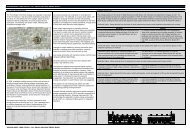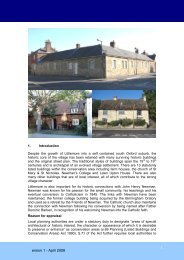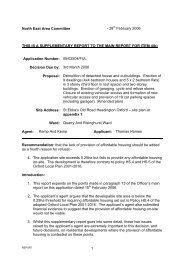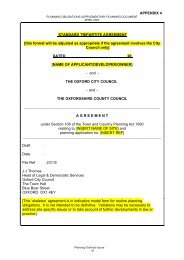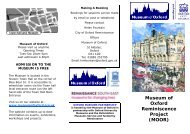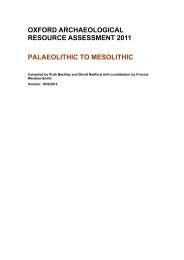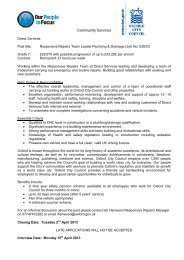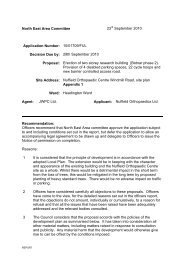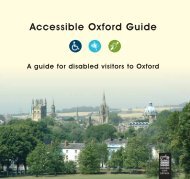Post-medieval Oxford - Oxford City Council
Post-medieval Oxford - Oxford City Council
Post-medieval Oxford - Oxford City Council
You also want an ePaper? Increase the reach of your titles
YUMPU automatically turns print PDFs into web optimized ePapers that Google loves.
Material culture<br />
The categories of ceramics, sealed bottles, and clay pipes have notably been subject<br />
to dedicated study (Leeds 1941; Haslam 1969; 1970; Biddle 1988; Banks 1997).<br />
Wall-paintings have also been recorded and published (Leeds 1936; Rouse 1972;<br />
Airs and Rhodes 1980; Munby 1992). The extensive St Ebbe’s/Westgate excavations<br />
in the 1960s and 1970s provided the first opportunity to study a wide range of post<strong>medieval</strong><br />
material from well recorded contexts (Rhodes 2006). This material has<br />
established a framework and set of type series for post-<strong>medieval</strong> material culture in<br />
the town (Hassall and Halpin et al. 1984). Subsequent, smaller-scale discoveries<br />
have built on this work. The St Ebbe’s material included a range of artefact types<br />
from the 16th to the mid-19th century: pottery, coins, tokens and counters; dress and<br />
harness fittings; iron knives, tools, keys and horse equipment; bone and ivory combs,<br />
brushes and knife handles; glass bottles (including seals) and flasks; drinking<br />
glasses; window glass; clay tobacco pipes; hair and wig curlers; roof and floor tiles.<br />
Pottery<br />
Three basic wares are common from this period – earthenware, stoneware and<br />
porcelain each of which have two basic sub-divisions depending on whether they are<br />
coarse wares for cooking and utility needs, while fine wares are more frequently<br />
decorated and are for serving or display. The development of pottery styles from the<br />
16th-19th centuries in <strong>Oxford</strong> is summarised by Mellor (1997). The identification and<br />
understanding of pottery fabrics remains the most common way to date features in<br />
most archaeological investigations but they can also provide evidence for trade and<br />
distribution, socio-economic factors, technological advances as well as providing site<br />
specific information through the types of vessels used (Mellor 1994a: 9).<br />
Much of the Ashmolean reserve collections of post-<strong>medieval</strong> pottery remain<br />
unpublished. A number of notable assemblages during the late 19th and early 20th<br />
century are summarised by Mellor (1997). A substantial assemblage of post<strong>medieval</strong><br />
pottery was recovered during the demolition of Oriel College owned<br />
properties on the High and the creation of King Edward Street in 1871-5, notably a<br />
collection of tin glazed earthenwares unparalleled in the city. Elsewhere, notable<br />
assemblages were recovered from Civet Cat (adj No 3 Cornmarket), 36 Cornmarket<br />
Street and the Masonic Hall, High Street produced assemblages of late 16th century<br />
German stonewares, some with portrait medallions (Mellor 1997: 74-5). The Fleurde-Luce<br />
at Carfax produced a collection of mid-17th century pottery including some<br />
interesting imports and the Bodleian Library tunnel excavated across the <strong>City</strong> Ditch<br />
found it to contain dumps of mid-17th pottery associated with the Civil War (Mellor<br />
1997: 76-7).<br />
Excavations in 1899 at the Clarendon Building also produced Rhenish stonewares of<br />
a mid-late 17th century date. Large interventions like the construction of the<br />
underground bookstore for the Bodleian in Radcliffe Square in 1909 and the building<br />
of the New Bodleian extension on Broad Street in 1937 also produced large post<strong>medieval</strong><br />
assemblages (Lawrence and Emden et al. Archive Bodl. M.S. Top. Oxon;<br />
Bruce-Mitford 1939).<br />
The rescue excavations in St Ebbe’s during the 1960s and 1970s produced the<br />
largest collection of well stratified post-<strong>medieval</strong> material (Hassall 1984). The 16th<br />
century assemblage was small and fairly typical largely comprising red earthenware,<br />
probably Brill/Boarstall ware. A notable absence of cooking vessels however,<br />
indicated that other non-ceramic vessels were being used (Mellor 1984: 214). The<br />
17th century assemblage demonstrated an increase in the quality and variety of<br />
vessels in use in the intra-mural area. This included a high number of tankards<br />
OXFORD ARCHAEOLOGICAL RESOURCE ASSESSMENT- POST MEDIEVAL<br />
59



